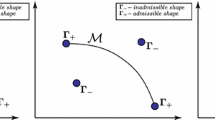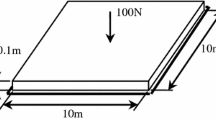Abstract
This study focuses on learning of control commands identification and load identification for active shape control of a tensegrity structure in situations of unknown loading event. Control commands are defined as sequences of contractions and elongations of active struts. Case-based reasoning strategies support learning. Simple retrieval and adaptation functions are proposed. They are derived from experimental results of load identification studies. The proposed algorithm leads to two types of learning: reduction of command identification time and increase of command quality over time. In the event of no retrieved case, load identification is performed. This methodology is based on measuring the response of the structure to current load and inferring the cause. It provides information in order to identify control commands through multi-objective search. Results are validated through experimental testing.
Preview
Unable to display preview. Download preview PDF.
Similar content being viewed by others
References
Kawaguchi, K., Pellegrino, S., Furuya, H.: Shape and Stress Control Analysis of Prestressed Truss Structures. Journal of Reinforced Plastics and Composites 15, 1226–1236 (1996)
Djouadi, S., Motro, R., Pons, J.C., Crosnier, B.: Active Control of Tensegrity Systems. Journal of Aerospace Engineering 11, 37–44 (1998)
Sultan, C.: Modeling, design and control of tensegrity structures with applications, PhD thesis, Purdue Univ., West Lafayette, Ind. (1999)
Skelton, R.E., Helton, J.W., Adhikari, R., Pinaud, J.P., Chan, W.: An introduction to the mechanics of tensegrity structures. In: Handbook on mechanical systems design. CRC, Boca Raton (2000)
Kanchanasaratool, N., Williamson, D.: Modelling and control of class NSP tensegrity structures. International Journal of Control 75(2), 123–139 (2002)
Van de Wijdeven, J., de Jager, B.: Shape Change of Tensegrity Structures: Design and Control. In: Proceedings of the American Control Conference, Protland, OR, USA, pp. 2522–2527 (2005)
Fest, E., Shea, K., Smith, I.F.C.: Active Tensegrity Structure. Journal of Structural Engineering 130(10), 1454–1465 (2004)
Domer, B., Smith, I.F.C.: An Active Structure that learns. Journal of Computing in Civil Engineering 19(1), 16–24 (2005)
Kolodner, J.L.: Case-Based Reasoning. Morgan Kaufmann Publishers Inc., San Mateo (1993)
Leake, D.B.: Case-based reasoning: Experiences, lessons, & future directions. In: Leake, D.B. (ed.). California Press, Menlo Park (1996)
Leake, D.B., Wilson, D.C.: When Experience is Wrong: Examining CBR for changing Tasks and Environments. In: Althoff, K.-D., Bergmann, R., Branting, L.K. (eds.) ICCBR 1999. LNCS (LNAI), vol. 1650, p. 218. Springer, Heidelberg (1999)
Müller, K.R., Mika, S., Rätsch, G.K.T., Shölkopf, B.: An Introduction to Kernel-Based Learning Algorithms. IEEE Transactions on Neural Networks 12(2), 181–201 (2001)
Purvis, L., Pu, P.: Adaptation Using Constraint Satisfaction Techniques. In: ICCBR 1995. LNCS (LNAI), vol. 1010, pp. 289–300. Springer, Sesimbra (1995)
Marling, C., Sqalli, M., Rissland, E., Munoz-Avila, H., Aha, D.: Case-Based Reasoning Integrations. AAAI, Menlo Park (Spring 2002)
Waheed, A., Adeli, H.: Case-based reasoning in steel bridge engineering. Knowledge-Based Systems 18, 37–46 (2005)
Bailey, S., Smith, I.F.C.: Case-based preliminary building design. Journal of Computing in Civil Engineering, ASCE 8(4), 454–468 (1994)
Ljung, L.: System identification-theory for the users. Prentice-Hall, Englewood Cliffs (1999)
Park, G., Rutherford, A.C., Sohn, H., Farrar, C.R.: An outlier analysis framework impedance-based structural health monitoring. Journal of Sound and Vibration 286, 229–250 (2005)
Vanlanduit, S., Guillaume, P., Cauberghe, B., Parloo, E., De Sitter, G., Verboven, P.: On-line identification of operational loads using exogenous inputs. Journal of Sound and Vibration 285, 267–279 (2005)
Haralampidis, Y., Papadimitriou, C., Pavlidou, M.: Multi-objective framework for structural model identification. Earthquake Engineering and Structural Dynamics 34, 665–685 (2005)
Maeck, J., De Roeck, G.: Damage assessment using vibration analysis on the z24-bridge. Mechanical Systems and Signal Processing 17, 133–142 (2003)
Lagomarsino, S., Calderini, C.: The dynamical identification of the tensile force in ancient tie-rods. Engineering Structures 27, 846–856 (2005)
Robert-Nicoud, Y., Raphael, B., Smith, I.F.C.: System Identification through Model Composition and Stochastic Search. Journal of Computing in Civil Engineering 19(3), 239–247 (2005)
Adam, B., Smith, I.F.C.: Self Diagnosis and Self Repair of an Active Tensegrity Structure. Journal of Structural Engineering (in review)
Adam, B., Smith, I.F.C.: Tensegrity Active Control: a Multi-Objective Approach. Journal of Computing in Civil Engineering (2006)
Author information
Authors and Affiliations
Editor information
Editors and Affiliations
Rights and permissions
Copyright information
© 2006 Springer-Verlag Berlin Heidelberg
About this paper
Cite this paper
Adam, B., Smith, I.F.C. (2006). Self-aware and Learning Structure. In: Smith, I.F.C. (eds) Intelligent Computing in Engineering and Architecture. EG-ICE 2006. Lecture Notes in Computer Science(), vol 4200. Springer, Berlin, Heidelberg. https://doi.org/10.1007/11888598_2
Download citation
DOI: https://doi.org/10.1007/11888598_2
Publisher Name: Springer, Berlin, Heidelberg
Print ISBN: 978-3-540-46246-0
Online ISBN: 978-3-540-46247-7
eBook Packages: Computer ScienceComputer Science (R0)




